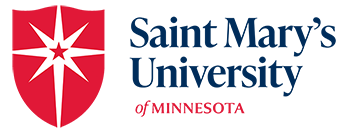When Ifrah Mohamed B’16 moved to the United States from Somalia 14 years ago, she barely knew English. Any time she went to the doctor, she needed help from an interpreter. Today, Mohamed is the manager of Language Services for Allina Health, where she coordinates interpreter services for thousands of patients who are in the same situation she was in back in 2008.
“As you can hear, I have an accent. I used to get interpreters and rely on that to communicate with my providers, because I couldn’t speak English,” said Mohamed, who graduated from Saint Mary’s Healthcare and Human Services Management program (now called B.S. Healthcare Management.) “It’s challenging [for patients]. It sometimes feels like you cannot hear or you’re confused. That’s why I understand if a patient does speak, they’re going to speak their language and they can ask all the questions through the interpreter. We teach our interpreters to act invisible with the provider and the patient, because we want the providers to talk directly to the patient. It’s not like they are talking about the patient to the interpreter.”
Mohamed oversees a team of 50+ employees at Allina Health which coordinates services from 40 certified interpreters. They offer seven languages: American Sign Language, Arabic, Hmong, Russian, Somali, Spanish, and Vietnamese. The interpreters work remotely in many cases, offering phone or video services, and they also offer in-person interpreters at the 12 hospitals and more than 90 clinics in the Allina Health system, which serves Minnesota and western Wisconsin.
Access to these interpreter services is “an American right,” Mohamed said. “Every patient has the right to have an interpreter available; it is their civil right.”
Plus, clear communication between patients and providers leads to better treatment and outcomes. “We cannot deliver care if we don’t understand or communicate better,” she said.
Mohamed had an associate’s degree and knew she wanted to work in health care, but not in a clinical role, when she found Saint Mary’s Healthcare and Human Services Management program. The program is tailored for students who already have credits and need to complete their bachelor’s degree. For Mohamed, the evening classes were convenient for her schedule, since she worked full time at a childcare center during the day.
“After I finished my two-year degree, I knew that I wanted to be in health care, but I didn’t want to be a nurse or a doctor. I wanted to be in leadership. I thought, ‘How can I help people?’” she said. “I searched a lot of schools, and Saint Mary’s was the best choice because of the timing it offers.”
Susan Jarosak, the interim dean in the School of Health and Human Services, encouraged Mohamed to apply and attend Saint Mary’s and then became a mentor to her while she was a student. Mohamed recalls frequently stopping by Jarosak’s office with questions and guidance. “So I didn’t have anyone who can help with the process of attending a university,” Mohamed said. “Susan never said, ‘I don’t have time.’ She was my mentor, and she is still somebody I always have on my mind. To this day, I recommend anyone seeking or furthering their educational endeavors to talk to Susan Jarosak at Saint Mary’s.
“I’m the first family member who ever went to college in my family. And the reason I was working and studying full time is because I wanted to bridge the language barrier and strengthen our community’s access to better health care services,” she added. Mohamed said that the management skills she learned at Saint Mary’s help her as she creates the budget and staffing plans for her department.
“How many positions do you need? What is missing? I have to assess that, and also the budget. What do we need for the year?” she said. “Do we need to add employees or offer more languages? Saint Mary’s empowered and prepared me to become the manager I am today.
“Nelson Mandela said, ‘When you speak to a man in his language … the message goes to his heart,’ and one of the barriers Allina Health is bridging is languages, so it can better serve our communities and beyond boundaries.”
By Maura Sullivan Hill

